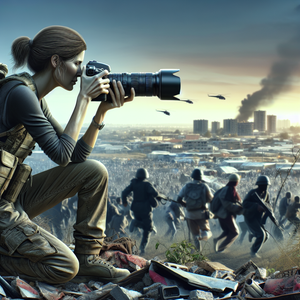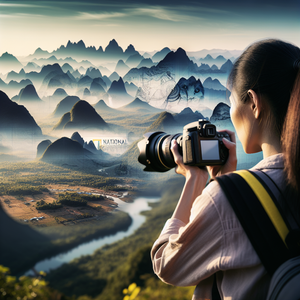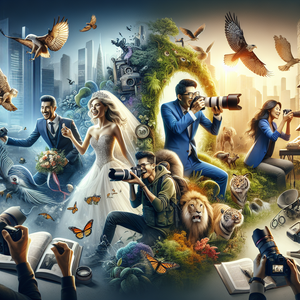
Navigating the World of Conflict Photography: Pathways, Skills, and Realities
Conflict photography is a deeply impactful profession that captures the essence of human experiences amid crisis and chaos. This field, closely linked with war photography, plays a crucial role in documenting the often-overlooked stories of individuals affected by conflict. To thrive as a conflict photographer, one must possess not only technical skills but also a profound understanding of the ethical and emotional weight of their work. The journey to becoming a conflict photographer is multifaceted; it requires building a compelling portfolio, gaining practical experience, and forming connections within the industry.
Job Summaries:
Conflict Photographer:
- Conflict photographers are the frontline storytellers, capturing the human experience in war-torn areas or during civil unrest.
- To excel, one must master technical photography skills while managing the pressures of hazardous environments.
- A strong portfolio, a background in journalism or photography, and an understanding of the ethical implications of their work are essential.
- Networking within media circles can lead to commissioned projects, making connections a critical component of success.
War Photojournalist:
- War photojournalists narrate the stories of armed conflicts through their lenses.
- They often accompany military units or humanitarian groups.
- This role demands exceptional photography skills.
- Quick instincts for capturing pivotal moments are essential.
- A degree in journalism or a related field is typically preferred.
- Field reporting experience carries significant weight.
- Understanding the complexities of conflict is crucial.
- Navigating sensitive situations is paramount for success in this role.
Military Photographer:
- Military photographers document the activities of armed forces in both combat and non-combat scenarios.
- This position often requires military service, where photographers receive specialized training that blends photography and adherence to military protocols.
- A deep understanding of military culture and the ability to thrive in high-stress settings are critical to success.
- Technical skills in photography and videography, along with proficiency in editing software, are essential for this role.
Freelance Conflict Photographer:
- Freelance conflict photographers operate independently.
- They sell their images to media outlets, NGOs, and publications.
- This role demands a robust portfolio.
- Exceptional networking abilities are required.
- Self-marketing skills are essential.
- Freelancers must be adaptable.
- They often work in unpredictable environments.
- Photographers are responsible for their own logistics and safety.
- A background in photojournalism or equivalent experience can enhance prospects in this competitive field.
Documentary Photographer:
- Documentary photographers focus on storytelling through visuals, often addressing social issues, including conflicts.
- A strong sense of composition and the ability to convey powerful narratives are vital.
- While formal education in photography or visual arts can be beneficial, hands-on experience and an engaging portfolio are more critical.
- These photographers frequently engage in long-term projects, allowing them to build authentic connections with their subjects.
Photo Editor for Conflict Reporting:
- Photo editors in conflict reporting are tasked with curating and presenting images for publications that cover war and strife.
- A discerning eye for impactful imagery and understanding the ethical dimensions of photojournalism are crucial.
- These editors collaborate closely with photographers to shape visual narratives that resonate with audiences, influencing public perception of conflicts.
Crisis Management Consultant for Photographers:
- Crisis management consultants for photographers provide training and protocols for operating safely in conflict zones.
- This role demands a thorough understanding of the risks involved and strategies for risk mitigation.
- Consultants often offer training on situational awareness, emergency response, and ethical considerations in crisis documentation.
Visual Storyteller:
- Visual storytellers use photography to share narratives around human experiences.
- Often shining a light on social issues, including conflict.
- This role requires a blend of creativity and journalistic integrity.
- Necessitating a deep engagement with subjects.
- A keen eye for detail and a passion for storytelling are essential.
- Alongside technical proficiency in photography and editing.
Photojournalism Educator:
- Photojournalism educators train aspiring photographers in the skills required to capture compelling stories through images.
- This role typically requires a master's degree in journalism or a related field, along with substantial experience in photojournalism.
- Educators play a crucial role in preparing the next generation of photographers to tackle critical global issues.
Safety Trainer for Photographers:
- Safety trainers deliver essential training on best practices for working in conflict zones.
- This role involves creating curricula that address situational awareness, risk assessment, and emergency response protocols.
- Trainers often come from backgrounds in security, military, or emergency services, using their expertise to ensure that photographers are prepared for the realities of their work.
The journey to becoming a conflict photographer is varied and rich, reflecting the diverse nature of the field. Each role, from freelance photographers to educators, contributes uniquely to the vital task of documenting and understanding human experiences during crises. As you consider your path in this challenging yet rewarding career, it’s essential to acknowledge the emotional and ethical complexities inherent in conflict photography. Seek mentorship from seasoned professionals, continuously refine your skills, and immerse yourself in the current trends shaping the industry. Engaging with the growing demand for visual storytelling can help you navigate this impactful journey. Numerous resources and job listings are available to assist you in taking those initial steps toward a fulfilling career in conflict photography.
Explore More Jobs
